Covers are essential for a safe, energy-efficient swimming pool
by Sally Bouorm | August 1, 2011 2:20 pm
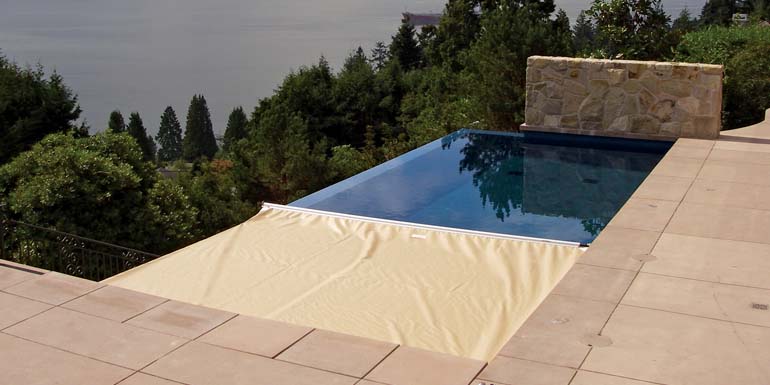 [1]
[1]By Jenn Blum
An automatic swimming pool safety cover allows homeowners to readily enjoy leisure time at their pool. By simply entering their activation code on the cover control and pressing uncover, in less than one minute, a family can be ready to enjoy pool water that is clean, sparkling and at the perfect temperature. After taking a few hours for a refreshing swim, fun with the kids, or even just a float about in the pool, the homeowner simply recovers the pool and carries on with their day.
However, pool professionals know there is still a flurry of activity back at the pool. The filter, pump, heating system, cleaners, sanitizers, controls and the pool cover are all working together as a team to preserve the perfect pool experience with maximum efficiency.
What is the pool equipment team fighting for? Balanced, clean water at a comfortable temperature, giving the pool owner peace of mind by making pool operation more convenient, energy efficient and fun. What is the team fighting against? The buildup of dirt, debris, leaves and contaminants, and reducing heat, chemical and water loss. In the game of pool maintenance, an automatic safety cover is the homeowner’s defensive line.
Safety first
Uncovered pools are tempting to children and pets. First and foremost, a safety cover provides protection against unattended access to the pool.
All swimming pool safety products, such as locking doors, gates and fences, pool alarms and safety covers can contribute to a safer pool. However, when an outdoor pool is unattended or the pool owner is away, a safety cover can be the most effective way to create a secure safety barrier.
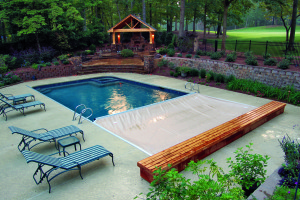 [2]
[2]Homeowners looking to install a safety cover have several options. They can choose between an automatic cover, a manual cover with tracks and reel system, or a manual anchored system. These vinyl or mesh covers are attached to the pool coping or deck surface and can support the weight of several adults. All types of solid-weave vinyl safety covers offer added benefits of keeping the pool free of dirt, while also preventing water, heat and chemical evaporation. The main differences between each cover system are their ease of use and convenience factors, as well as the available architectural options.
Future pool owner, Jodi Emery, cites convenience as her number one reason for including an automatic cover system in her building plans. As the parent of a curious and independent three-year old boy, she knows the allure of pool water and the need for a protective barrier.
“You can’t get much easier than typing in a code and pressing a button to cover and uncover your pool,” says Emery. “With an automatic cover, we have no excuse not to keep the pool covered whenever we’re not using it.”
The key aspect is convenience: if the pool owner does not actually cover the pool, then the safety cover’s benefits are irrelevant.
Winning the game against evaporation
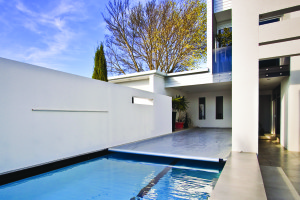 [3]
[3]In colder climates, energy costs are some of the highest ongoing expenses for outdoor pool and swim spa owners. Pool water gains heat from the pool heater (either gas, electric or solar) and directly from the sun. Pool water loses heat through radiation, conduction, convection and evaporation. The first three typically account for 30 per cent of thermal loss. On an uncovered pool, the remaining 70 per cent is typically caused by evaporation—the number one enemy of an efficient pool.
Wind, humidity, air/water temperature and pool activity all contribute to the evaporation level. In turn, evaporation takes valuable heat, chemicals and, most obviously, treated water out of the pool. Each evaporating litre of 27 C (87.6 F) pool water can take over 2,000 British thermal units (Btus) of heat with it. All of the wasted resources need to be replaced to get the pool water back to ideal levels, balance and temperature. Even the most energy-efficient pool heater has to work diligently to replace the heat.
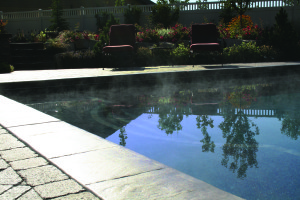 [4]
[4]Adding a vapour barrier, such as a vinyl safety cover, can prevent the energy, chemical and water loss from evaporation when the pool or swim spa is not occupied. This also means the pool equipment can be appropriately sized for the pool’s needs and the owner’s budget.
While above-ground pools experience a higher percentage of thermal loss from conduction, they will also have evaporative losses similar to inground pools. These pools can still benefit from a cover system as long as there is room on a deck surface for parallel guides to be installed along the pool side.
For indoor pools and spas, managing humidity levels is one of the biggest challenges. Dehumidification systems can be quite an investment to install and operate; however, including a cover system can dramatically cut down on dehumidification needs.
“The difference in humidity levels was quickly apparent,” says Jack Clark, a tri-athlete who uses his indoor current pool for training and family recreation. “After we finished construction, there were a few days when the pool was heated but uncovered. Water was dripping off of the walls inside the basement and the outside wall was wet to the touch. The building was sweating. Once we finished the cover installation and were able to keep the pool covered, the humidity went away.”
How much can a pool owner save?
The amount of saved resources between a covered and uncovered pool is a function of the evaporation rate and pool usage, while financial savings are determined by the pool owner’s cost to replace the lost resources.
Estimating evaporation rate and pool usage
For existing pools, the easiest way to determine the amount of water escaping the pool is to measure the water level difference over the period of one week. Multiply the pool’s surface area by the change in water level to determine the volume of balanced, heated water that will need to be replaced each week. Then, multiply this figure by the number of weeks in the swimming season to estimate seasonal water loss. Keep in mind, this amount will also include water loss from pool splash, backwashing and any leaks.
For new pool projects, potential evaporation rates have to be estimated. For the most comprehensive estimate, historical climate data can be used as a reference point to develop a picture of typical conditions for a particular area. These conditions consider the relationships between many variables to determine evaporation rates (e.g. air temperature, relative humidity, water temperature, uncovered pool surface area, wind speed and pool activity). The climate data also allows pool owners to estimate their pool usage in addition to how often the pool will be covered versus uncovered.
Energy savings
Energy efficiency is one of the most significant benefits of reducing evaporation with a pool cover. For a simple comparison, look at the estimated energy usage[5] between mid-May and September for an outdoor, inground 60 m2 (646 sf) pool in Montreal, Toronto and Vancouver. The pool is used moderately for about nine hours during optimal days (defined for this scenario as a minimum of 18 C [64.4 F] on sunny days or 23 C [73.4 F] on cloudy days). The water temperature is set to a minimum 25 C (77 F).
In these three cities, the energy usage calculator estimates seasonal energy savings of 90 to 150 gigajoules (GJ) for a pool that is covered when it is not actively being used. With a cover, the pool heating system only needs to provide 30 to 35 per cent of the heat an uncovered pool requires, which represents a 65 to 70 per cent savings.
If the pool owner wishes to extend their swimming season, a cover becomes even more valuable in managing heat loss. While pool usage, number of optimal days and overall energy consumption might vary between pool owners, the energy savings from the pool cover ‘line of defense’ can translate into hundreds and even thousands of dollars each season.
Water, chemical and equipment savings
Water conservation and reduced chemical use are also benefits of a cover system. For example, during drought periods and water restrictions, the pool owner will require less make up water to return to proper operating levels. The cover acts as a vapour barrier to prevent treated water from evaporating; this can save time and excessive chemicals required to bring the water back to balance.
Furthermore, by curtailing unnecessary evaporation, wear and tear on the pool’s surface and equipment is also reduced. Over the life of the pool, these benefits can add up to significant savings.
Adding a pool cover to the team
An automatic safety cover can be installed on a pool during new construction or remodelling, or it can be retrofitted to an existing pool if the cover was not included in the initial plans. For current pool owners, the return on investment (ROI) will be readily apparent since they are familiar with the particular costs associated with owning their pool. For new pool owners, estimating the financial savings for energy, water, chemical and operating costs can help justify the upfront investment in an automatic safety cover. In both cases, consumers are continually educating themselves about the extra benefits safety covers offer in addition to the custom options that are available.
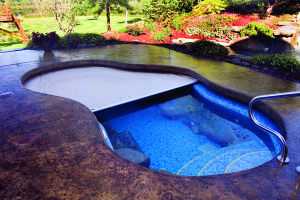 [6]
[6] [7]
[7]Al Horwood of Pool Patrol, an installer of automatic safety covers in Vancouver, B.C., says he is getting more calls about pool covers from homeowners who are in the planning and design phase of a new pool.
“Before they even dig, they want to consider how they’re going to protect the pool,” says Horwood. “They’re doing research on the Internet, contacting experts and figuring out their options.”
Many of these homeowners are incorporating automatic covers on vanishing-edge pools and elaborate pool designs with water features, so it pays to plan ahead and consider all of the available architectural options, he says.
“With custom lids and hidden leading edges, for example, some of these installations require extra site visits and extra time,” Horwood adds. “However, the end result is an impressive showpiece.”
A winning defense
Ultimately, the automatic pool cover works defensively on the front line to protect the pool, while also keeping the ownership experience fun, convenient, safe and efficient. An MVP in the lineup of essential pool equipment, safety covers deliver the stats for efficiency, safety and convenience so that families can spend more time simply enjoying their pools.
 Jenn Blum is marketing director for Cover-Pools Inc., a subsidiary of Zodiac Pool Systems, Inc. She has worked in sales and marketing for more than 18 years and has been part of the Cover-Pools team since 2001. She can be reached via e-mail at jenn.blum@zmp-zodiac.com[8].
Jenn Blum is marketing director for Cover-Pools Inc., a subsidiary of Zodiac Pool Systems, Inc. She has worked in sales and marketing for more than 18 years and has been part of the Cover-Pools team since 2001. She can be reached via e-mail at jenn.blum@zmp-zodiac.com[8].
- [Image]: http://poolspamarketing.com/wp-content/uploads/2011/08/Cover-Pools-PSM-8.jpg
- [Image]: http://www.poolspas.ca/wp-content/uploads/2015/06/Cover-Pools-PSM-4.jpg
- [Image]: http://www.poolspas.ca/wp-content/uploads/2015/06/Cover-Pools-PSM-5.jpg
- [Image]: http://www.poolspas.ca/wp-content/uploads/2015/06/Cover-Pools-PSM-evap-heat.jpg
- estimated energy usage:
- [Image]: http://www.poolspas.ca/wp-content/uploads/2015/06/Cover-Pools-PSM-9.jpg
- [Image]: http://www.poolspas.ca/wp-content/uploads/2015/06/Cover-Pools-PSM-3.jpg
- jenn.blum@zmp-zodiac.com: mailto:jenn.blum@zmp-zodiac.com
Source URL: https://www.poolspamarketing.com/trade/covers-are-essential-for-a-safe-energy-efficient-swimming-pool/